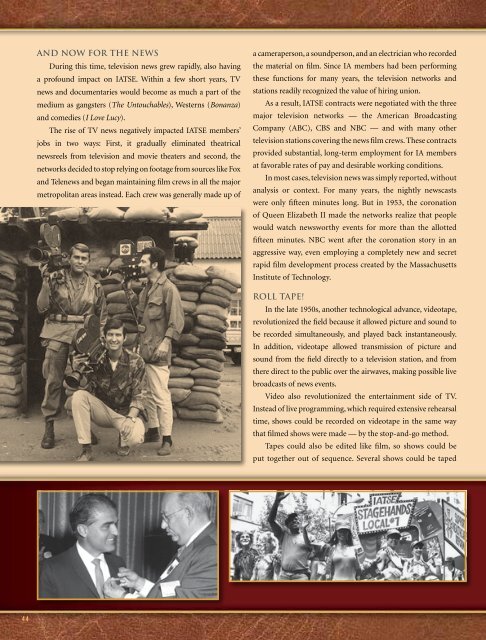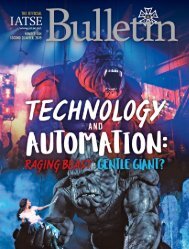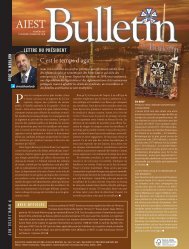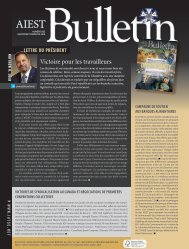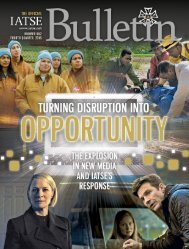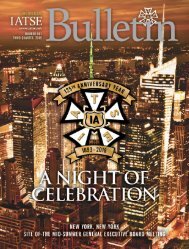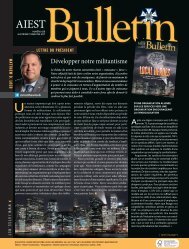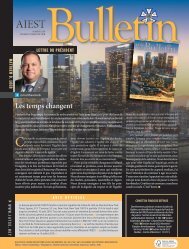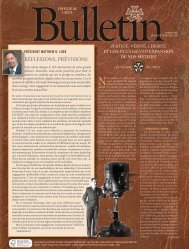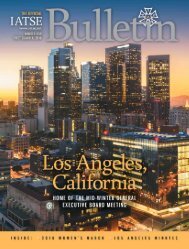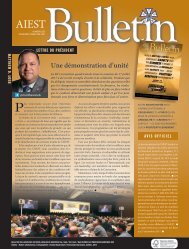IATSE-2nd2018_web
You also want an ePaper? Increase the reach of your titles
YUMPU automatically turns print PDFs into web optimized ePapers that Google loves.
AND NOW FOR THE NEWS<br />
During this time, television news grew rapidly, also having<br />
a profound impact on <strong>IATSE</strong>. Within a few short years, TV<br />
news and documentaries would become as much a part of the<br />
medium as gangsters (The Untouchables), Westerns (Bonanza)<br />
and comedies (I Love Lucy).<br />
The rise of TV news negatively impacted <strong>IATSE</strong> members’<br />
jobs in two ways: First, it gradually eliminated theatrical<br />
newsreels from television and movie theaters and second, the<br />
networks decided to stop relying on footage from sources like Fox<br />
and Telenews and began maintaining film crews in all the major<br />
metropolitan areas instead. Each crew was generally made up of<br />
a cameraperson, a soundperson, and an electrician who recorded<br />
the material on film. Since IA members had been performing<br />
these functions for many years, the television networks and<br />
stations readily recognized the value of hiring union.<br />
As a result, <strong>IATSE</strong> contracts were negotiated with the three<br />
major television networks — the American Broadcasting<br />
Company (ABC), CBS and NBC — and with many other<br />
television stations covering the news film crews. These contracts<br />
provided substantial, long-term employment for IA members<br />
at favorable rates of pay and desirable working conditions.<br />
In most cases, television news was simply reported, without<br />
analysis or context. For many years, the nightly newscasts<br />
were only fifteen minutes long. But in 1953, the coronation<br />
of Queen Elizabeth II made the networks realize that people<br />
would watch newsworthy events for more than the allotted<br />
fifteen minutes. NBC went after the coronation story in an<br />
aggressive way, even employing a completely new and secret<br />
rapid film development process created by the Massachusetts<br />
Institute of Technology.<br />
ROLL TAPE!<br />
In the late 1950s, another technological advance, videotape,<br />
revolutionized the field because it allowed picture and sound to<br />
be recorded simultaneously, and played back instantaneously.<br />
In addition, videotape allowed transmission of picture and<br />
sound from the field directly to a television station, and from<br />
there direct to the public over the airwaves, making possible live<br />
broadcasts of news events.<br />
Video also revolutionized the entertainment side of TV.<br />
Instead of live programming, which required extensive rehearsal<br />
time, shows could be recorded on videotape in the same way<br />
that filmed shows were made — by the stop-and-go method.<br />
Tapes could also be edited like film, so shows could be<br />
put together out of sequence. Several shows could be taped<br />
44


